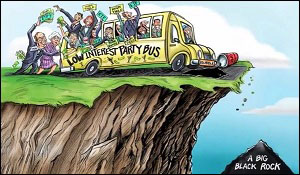By Pam Martens and Russ Martens: March 30, 2020 ~
In 2015, the legendary Wall Street investor, Carl Icahn, called BlackRock “an extremely dangerous company.” (See video clip below.) Icahn was specifically talking about BlackRock’s packaging of junk bonds into Exchange Traded Funds (ETFs) and calling them “High Yield,” which the average American doesn’t understand is a junk-rated bond. The ETFs trade during market hours on the New York Stock Exchange, giving them the aura of liquidity when one needs it. Icahn said: “I used to laugh with some of these guys…I used to say, you know, the mafia has a better code of ethics than you guys. You know you’re selling this crap.” Icahn warned that “if and when there’s a real problem in the economy, there’s going to be a rush for the exits like in a movie theatre, and people want to sell those bonds, and think they can sell them, there is no market for them.”
BlackRock not only sells junk-rated bond ETFs under the brand name iShares, but it has some of the largest investment grade corporate bond ETFs, including one that trades under the stock symbol LQD, which was experiencing serious losses and seeing major outflows of money until the Federal Reserve announced recently that it was creating three facilities to buy investment grade corporate debt from the primary and secondary markets, as well as investment grade corporate bond ETFs, along with agency commercial mortgage-backed securities.
And just who is going to be running these facilities for the Federal Reserve? None other than BlackRock – posing an enormous conflict of interest which was readily observable in the market as BlackRock’s investment grade ETFs rallied dramatically on the news.
According to the “Terms of Assignment” the New York Fed released, BlackRock will be allowed to buy up its own corporate bond ETFs as well as those of its competitors. The only caveat in the contract is this concerning the Fed’s Secondary Market Corporate Credit Facility (SMCCF):
“BlackRock will treat BlackRock-sponsored ETFs on the same neutral footing as third-party ETFs. All ETF transactions will be effected through intermediaries at market prices on a best execution basis, whether in the secondary market or via primary creations and redemptions. If the share of the SMCCF’s holding of BlackRock-sponsored ETFs exceeds or is expected to exceed the then-current market share of BlackRock-sponsored ETFs in the corporate bond ETF market on average over a given calendar month, BlackRock will notify the New York Fed for review and consultation. The New York Fed may direct portfolio adjustments at any time.”
This document labeled “Terms of Assignment” does not appear to be the full contract between the Fed and BlackRock for purchasing, selling and managing the Fed’s corporate bond portfolios.
A much more detailed contract appears on the New York Fed’s website for BlackRock’s management of the agency commercial mortgage-backed securities facility. That contract reveals this:
“…the Manager is hereby appointed as the FRBNY’s [Federal Reserve Bank of New York] agent in fact, and it shall have full power and authority to act on behalf of the Account with respect to the purchase, sale, exchange, conversion, or other transactions in any and all stocks, bonds, other securities, or cash held for investment subject to the Agreement…
“The Manager shall initially meet at least weekly with the FRBNY and any other investment managers participating in this FOMC directive to discuss strategy. Absent agreement from the FRBNY, these meetings should be attended only by individuals at the Manager who are behind the ethical wall established by the Manager…
“The Manager acknowledges that all information and material that comes into the possession or knowledge of the Manager on or after March 22, 2020…including the identity and amount of the assets held in the Account…shall be considered to be confidential and proprietary…providing the FRBNY, at the expense of the FRBNY, with all reasonable assistance in resisting or limiting disclosure.”
Picking a highly conflicted Wall Street firm to manage a taxpayer-subsidized bailout of the highly reckless and irresponsible securitization practices of Wall Street is nothing new for the Federal Reserve and its unlimited money spigot, the New York Fed. The Fed did the same thing during the financial crisis of 2008. (See The New York Fed Has Contracted JPMorgan to Hold Over $1.7 Trillion of its QE Bonds Despite Two Felony Counts and Serial Charges of Crimes.)


